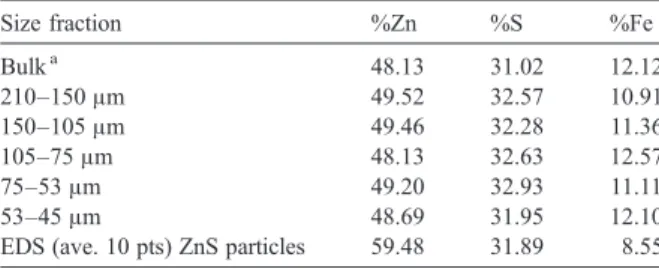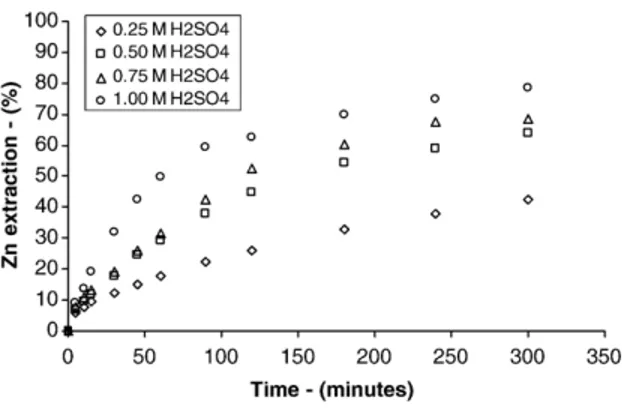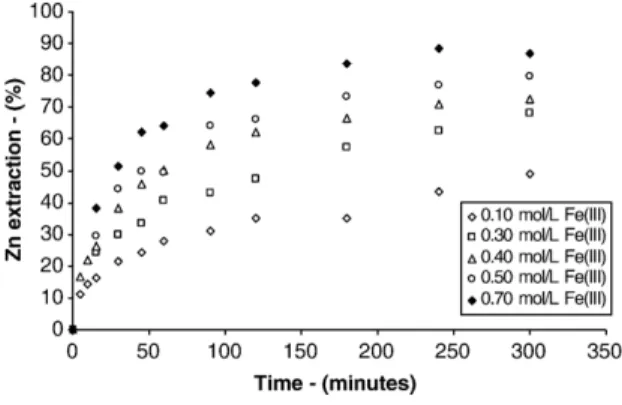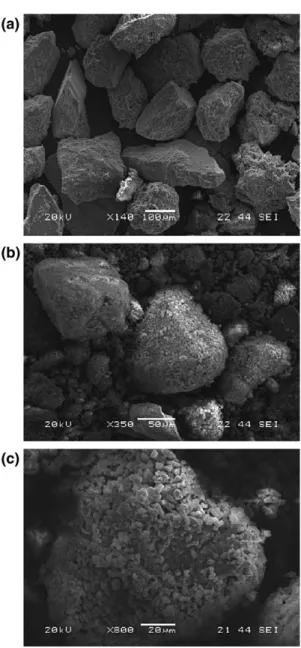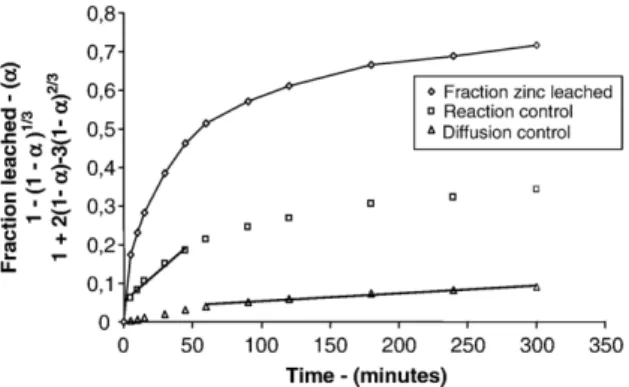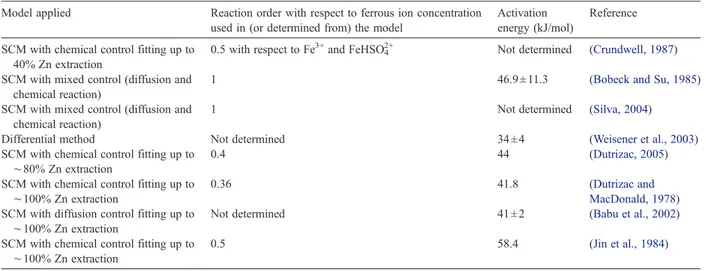The leaching kinetics of a zinc sulphide concentrate
in acid ferric sulphate
A.D. Souza
a, P.S. Pina
b, V.A. Leão
b,⁎
, C.A. Silva
b, P.F. Siqueira
ba
Votorantim Metais Zinc-Technologies Development Centre, BR 040, Km 274-Três Marias, MG, 39205-000, Brazil
bUniversidade Federal de Ouro Preto, Dept. Metallurgical and Materials Engineering. Núcleo de Valorização de Materiais Minerais-NVMM,
Praça Tiradentes, 20, Centro, Ouro Preto, MG, 35400-000, Brazil
Received 18 December 2006; received in revised form 17 May 2007; accepted 18 May 2007 Available online 26 May 2007
Abstract
This work examines the dissolution kinetics of an iron–rich zinc sulphide concentrate in acid ferric sulphate medium. The effects of temperature, ferric ion and sulphuric acid concentrations, agitation speed and particle size on the leaching kinetics were investigated. The leaching process could be separated into two stages. Initially, the dissolution kinetics was controlled by the chemical reaction at the surface of the zinc sulphide particles followed by a second step where the reaction was controlled by diffusion of the reagents or products through the elemental sulphur (ash) layer. The activation energy of the chemical controlled step was 27.5 kJ/mol and the value determined for the diffusion controlled step was 19.6 kJ/mol. The reaction order with respect to ferric ion and sulphuric acid concentrations were approximately 0.50 and 1.00, respectively. Analysis of the unreacted and reacted sulphide particles by SEM-EDS showed a progressive increase of the thickness of the elemental sulphur layer on the solid surface. The development of this sulphur layer is further evidence of the change on the rate-controlling step as the reaction progress. © 2007 Elsevier B.V. All rights reserved.
Keywords:Sphalerite; Chemical leaching; Ferric sulphate; Kinetics; Mechanism
1. Introduction
TheRoast-Leach-Electrowinning Process(RLE) has produced metallic zinc since 1916 and is currently responsible for more than 85% of the total zinc pro-duction (Souza et al., 2007). Notwithstanding, the RLE route has many restrictions to treat zinc concentrates high in silica, calcium, copper and iron. Also, the pre-vention of SO2emission from the process and marketing
of sulphuric acid are challenging the future of this technology (Deller, 2005).
Over the last few years, several innovative leaching processes have been proposed, such as bioleaching and chemical leaching as an integrated process (Souza et al., 2007), persulphate leaching (Babu et al., 2002), heap bioleaching (Lizama et al., 2003; Madhuchbanda et al., 2003), sulphide and silicate leaching integration (Souza et al., 2007) and solvent extraction for zinc recovery from oxide ores (Garcia et al., 2000). Some of these innovations have made the zinc industries more competitive. Others, however, require further develop-ment. For instance, the Três Marias Zinc Plant (Votorantim Group in Brazil) is in the first quartile of lowest metallurgical costs as it uses a new technology integrating sulphide and silicate concentrate treatment. Likewise, Skorpion Zinc (Anglo American Group), in
⁎Corresponding author. Tel.: +55 31 3559 1102; fax: +55 31 3559 1561.
E-mail address:versiane@demet.em.ufop.br(V.A. Leão).
Namibia, has started its solvent extraction technology and it is expected to be the metal producer with the lowest cost (Souza et al., 2007).
Regarding chemical leaching, two similar routes were proposed in the 1970s to produce zinc as a substitute for the RLE process: (i) Direct Atmospheric Leaching
(Svens et al., 2003) in which zinc sulphide concentrates are leached directly with a ferric ion solution; and (ii)
Pressure Leaching that adopts a similar approach (Baldwin et al., 1995), except that leaching is carried out in autoclaves (14–15 atm oxygen pressure).
The kinetics of ferric ion leaching of sphalerite concentrates has been described by several authors (Bobeck and Su, 1985; Dutrizac, 1992, 2005; Markus et al., 2004; Perez and Dutrizac, 1991). It is agreed that elemental sulphur is the main oxidation product and the iron content plays a key role during leaching. Many authors have observed that temperature increases the leaching rate, however, the reported values of activation energy vary widely (Bobeck and Su, 1985; Perez and Dutrizac, 1991). Furthermore, the effect of acid concen-tration on zinc dissolution is also well characterized; but the reaction order with respect to the sulphuric acid concentration has been determined only by few research-ers (Crundwell, 1988).
The objective of this work was to assess the effects of some parameters such as temperature (40–90 °C), ferric ion concentration (0.10–1.00 mol/L), particle size, sulphuric acid concentration (0.25–1.00 mol/L) and agitation speed (240–600 min−1) on the dissolution
kinetics of a zinc sulphide concentrate. The Shrinking Core Model (SCM) with chemical reaction control and product layer diffusion control as well as the initial rate (IR) method were used to describe the dissolution kinetics of this concentrate.
2. Reaction model
The leaching of zinc sulphide in ferric sulphate solu-tions includes a heterogeneous reaction represented by
Fe2ðSO4Þ3 aqð ÞþZnSð ÞsY2FeSO4 aqð ÞþZnSO4 aqð ÞþS-ð Þs
ð1Þ
A major feature of this system is that the chemical reaction step and mass transport are coupled in series. Besides, one may assume that the solid particle retains its initial shape and that the chemical reaction occurs in a sharp interface between the original solid and the re-action product. Further assuming that the zinc sulphide particles have a spherical geometry and the chemical reaction is the rate-controlling step, the following
ex-pression of the shrinking core model can be used to describe the dissolution kinetics of the process ( Leven-spiel, 1999):
1 ð1 aÞ 1 3¼K
R:t;KR¼
b:ks:½Fe IIIð Þn
qZnS:ro
ð2Þ
Similarly, when the diffusion of ferric ion through the elemental sulphur layer is the rate-controlling step, the following expression of the shrinking core model can be used to describe the dissolution kinetics (Levenspiel, 1999):
1 3 1ð aÞ 2
3þ2 1ð aÞ ¼K D:t;
whereKD¼
6:b:Deff:½Fe IIIð Þ
qZnS:ro2
ð3Þ
where: α= the fractional conversion, KR= kinetic
pa-rameter for reaction control,KD= kinetic parameter for
product diffusion control, b= stoichiometric coeffi-cient (0.50 in this case—reaction (1)),ks= chemical
reaction rate constant, [Fe(III)] = ferric ion concen-tration, ρZnS= molar density of ZnS, r0= particle
ra-dius;n= order of reaction with respect to Fe(III) and
Deff= effective diffusion coefficient.
When the chemical reaction is the rate controlling-step a plot of 1–(1–α)1/3 versus time is a straight line with a slope of KR. If the process is controlled by
diffusion through the solid product layer, a plot of 1–3(1–α)2/3–2(1–α) versus time is also a straight line
whose slope is KD (Levenspiel, 1999).
In order to compare the values of activation energy and reaction order obtained from Eqs. (2) and (3), the initial rate of the zinc sulphide dissolution was determined at different temperatures and ferric ion concentrations. The initial rate parameters were determined by fitting the experimental data to a hyperbolic equation:
Zn
½ ¼ k1:t
k2þt
ð4Þ
where: [Zn] = zinc concentration, t= time, k1 and k2=
constants.
The initial dissolution rate is the slope of Eq. (4), at
t= 0. That means the ratio betweenk1andk2(k1/k2=K),
since the first derivate of Eq. (4) is:
d½Zn
dt ¼
k1:k2 k2þt
ð Þ2 ð5Þ
and for all purposes,Kcan be written asK=A·k· [Fe3+]n whereA= area of reaction,k= Arrhenius constant, [Fe3+] =
3. Experimental
Table 1 presents the chemical analysis of the bulk concentrate and the wet-screened fractions. It also presents the electron microprobe analysis of isolated sphalerite particles. The difference between the iron content observed by chemical and EDS analysis is due to the presence of small quantities of pyrite in the zinc concentrate. The average zinc and iron concentrations are 48% and 12%, respectively, with about 8.5% iron replacing zinc in the sphalerite itself.
The mineralogical analyses of the concentrate were carried out by SEM-EDS. The samples were coated with graphite by electro-deposition, using a Jeol JEE 4C instrument and observed in a JEOL JSM 5510 scanning electron microscope (SEM) with an accelerating voltage 0.5–30 kV. It was equipped with a spectrometer for microanalysis based on a energy dispersive X-ray spectroscopy system (EDS). Sphalerite is the main mineral phase and pyrite, quartz and galena were also present in minor quantities.
Table 2 presents the values of surface area, micro-pores volume and micromicro-pores area determined by nitrogen adsorption–desorption isotherm obtained from a Nova 1000 High Speed Gas Sorption Analyser (Quantachrome). The trends of surface area follow that of the particle porosity. A large sample (∼4.0 g) was
used and the Nova 1000 parameters: equilibration tolerance, time to remain in tolerance and maximum equilibration time were set at 0.05, 360 and 720, respectively, to improve the accuracy of the low surface area measurements.
The chemical leaching experiments were carried out batch-wise in a closed water-jacketed glass reactor using a solution volume of 500 mL and a solid concentration 0.5% (w/ v). Agitation was provided by a magnetic stirrer because mechanical stirring showed similar results but higher evaporation losses. Leaching solutions were prepared using reagent grade chemicals (Fe2
(SO4)3·5H2O and H2SO4, Synth) and distilled water.
At selected time intervals, a known amount (3 mL) of slurry was withdrawn and filtered. The zinc extraction was determined by analyzing zinc in solution by AAS (Perkin Elmer AAnalyst 100).
Scanning electron microscopy (SEM) was used to examine the morphology of the leaching residues-as above for the concentrate.
4. Results and discussion
4.1. Effect of agitation speed
Initial experiments established that an increase of stirring speed in the range of 240–600 min–1
does not increase the zinc extraction at the low solids density used. Therefore, the dissolution process does not seem to be controlled by mass transfer through the liquid boundary film. Therefore, in all experiments the stirring speed was kept at 480 rpm.
4.2. Effect of temperature
Fig. 1shows the change on zinc extraction with the leaching time as function of temperature in the range of
Table 1
Chemical analysis of bulk and different screened fractions of zinc sulphide concentrate and EDS analysis of individual sphalerite particles
Size fraction %Zn %S %Fe
Bulka 48.13 31.02 12.12
210–150μm 49.52 32.57 10.91
150–105μm 49.46 32.28 11.36
105–75μm 48.13 32.63 12.57
75–53μm 49.20 32.93 11.11
53–45μm 48.69 31.95 12.10
EDS (ave. 10 pts) ZnS particles 59.48 31.89 8.55
a
Also 0.21% Cd; 0.95% Cu; 0.002% Co; 1.28% Pb.
Table 2
Surface parameters of different screened fractions of zinc sulphide concentrate
Size fraction
Surface area (m2/g)
Micropores volume (cm3/g) × 10−3
Micropores area (m2/g)
210–150μm 0.88 3.41 1.06
150–105μm 0.56 2.42 0.73
105–75μm 0.76 2.84 1.03
75–53μm 0.83 2.92 1.09
53–45μm 0.69 3.52 0.90
45–38μm 0.80 3.80 1.09
40 °C to 90 °C. These results show that temperature has a major role on the zinc dissolution process. The zinc extraction is relatively slow in the experiments carried out at 40 °C (45%) but significantly increases as the leaching temperature rises and a high zinc extraction was observed at 90 °C (90%). Similar results were observed by Dutrizac and MacDonald (1978), Bobeck and Su (1985), and Aydogan et al. (2005) in leaching experi-ments carried out in ferric chloride solutions; byPerez and Dutrizac (1991) and Dutrizac (2005) in studies performed in ferric sulphate medium; and byBabu et al. (2002)with ammonium persulphate solutions.
4.3. Effect of acid concentration
Fig. 2presents the effect of sulphuric acid concentra-tion upon the zinc extracconcentra-tion as funcconcentra-tion of leaching time at a constant Fe(III) concentration. It can be seen that zinc extractions increase gradually with leaching time and sulphuric acid concentration indicating that an appre-ciable quantity of zinc sulphide could be dissolved di-rectly by sulphuric acid (Dutrizac, 2005). The direct acid dissolution of zinc sulphide produces H2S, in the absence
of oxygen, rather than elemental sulphur. Nevertheless, as there was no solution degassing in the present work, Eq. (6) has likely taken place despite a weak hydrogen sulphide smell in the beginning of the experiments:
ZnSþH2SO4þ1=2O2¼ZnSO4þS-þH2O ð6Þ
Dutrizac (2005) studied the effect of sulphuric acid concentration upon sphalerite dissolution in ferric sul-phate medium. The author observed that the zinc dissolution kinetic parameters, determined by the shrink-ing core model with chemical reaction control, were independent of acid concentration for acid concentrations
b0.10 mol/L, since the hydrolysis of ferric sulphate
produced acidity itself. However, for acid concentrations
N0.10 mol/L, the dissolution rate increased. Dutrizac (2005)attributed this faster kinetics to the existence of a parallel dissolution reaction involving H2S and its
subsequent oxidation by Fe(III), as represented by Eqs. (7) and (8).
If acid played a key role during the zinc sulphide dissolution, elemental sulphur was not produced at the particle surface. In contrast, the SEM/EDS analysis showed the existence of an elemental sulphur layer covering the ZnS particles during the leaching process and indicates that acid attack has a minor effect as compared to the presence of Fe(III). Similarly, Babu et al. (2002) also verified that the zinc extraction is function of sulphuric acid concentration, in experiments carried out in ammonium persulphate solutions.
ZnSþH2SO4¼ZnSO4þH2S ð7Þ
Fe2ðSO4Þ3þH2S¼2FeSO4þH2SO4þS- ð8Þ
4.4. Effect of particle size
Fig. 3presents the effect of the concentrate particle size on zinc extraction. The decrease in particle size enhanced the zinc dissolution, but it can be seen that particle size plays a minor role in the leaching process. The zinc extraction observed in the experiment carried out with the particle size between 38–45 μm is only
around 10% higher than that achieved in the experiment performed with particle size in the range of 210–
150μm. The small difference observed is probably due
to the negligible increase of solid surface area (BET surface area) with decreasing particle sizes as an effect of porosity and natural cracks (Table 2 and Fig. 4). Porosity of the concentrate would not be a factor in the
Fig. 2. Effect of sulphuric acid concentration on Zn extraction. (T= 70 °C, 0.5 mol/L Fe(III); 0.5 %solids (w/v); 480 rpm; size 75–53μm).
shrinking core model (SCM) applied to these experiments since it takes into consideration a sharp interface reaction. However, reactant porosity plays an important role if the reaction interface is diffused, meaning that the oxidation reaction proceeds inside the pores.Massaci et al. (1998)
also verified the non-significance of the effect of particle size in a factorial experiment carried out with a zinc sulphide ore in ferric sulphate media. The authors credited this behaviour to the presence of a natural porosity in the structure of the zinc sulphide particles as observed in
Fig. 4, but surface area and porosity data were not presented. Another important factor that must be considered is the high reactivity of iron–rich sphalerite that could have reduced the effect of particle size upon the zinc extraction (Aydogan et al., 2005; Bobeck and Su, 1985; Ghosh et al., 2002; Silva, 2004).
4.5. Effect of ferric ion concentration
Ferric ion is a strong oxidant used in the leaching of several metallic sulphides such as: chalcopyrite, covel-lite, bornite, sphalerite, etc. The leaching reaction di-rectly involves ferric ions, and it would be expected that the ferric sulphate concentration would have an important role in the zinc sulphide dissolution process.
Fig. 5presents the effect of ferric ion concentration on zinc extraction as function of leaching time. It can be noticed that zinc extraction increases gradually with the leaching time and ferric ion concentration which is consistent with that observed byDutrizac and MacDo-nald (1978), Perez and Dutrizac (1991), Aydogan et al. (2005), and Dutrizac (2005).
4.6. Morphology of the leaching residues
The morphology of the zinc sulphide concentrate before and after leaching was examined by SEM-EDS
(Fig. 6). The particles of the zinc sulphide concentrate before the leaching process present a clear surface and have approximately the same form and size (Fig. 6(a)). After the leaching progress, the micrographs of the leaching residues show a progressive increase in the roughness of the solid and also an increase in the amount of elemental sulphur covering the particle surfaces (Fig. 6
(b) and (c)). After 45% zinc extraction (Fig. 6(b)), the particles present their surface completely covered by an elemental sulphur layer, as proposed previously by
Bobeck and Su (1985) and Crundwell (1987).
5. Kinetics analysis
Dutrizac and MacDonald (1978) proposed that, during the oxidative leaching of ZnS, elemental sulphur would be formed preferably than sulphate, according the Eq. (1). The authors also determined that around 85% to 95% of the sulphide is oxidized into elemental sulphur. During the initial step of dissolution, the quantity of elemental sulphur produced is very low so that the diffusion resistance is small. As reaction proceeds, sulphur covers the zinc particle and as this layer increases in thickness, the diffusion of reagents or products through it may become the rate-controlling step. Therefore, it may not be reasonable to consider that just one step, chemical reaction or diffusion through the elemental sulphur layer, would control the entire process.
Eqs. (2) and (3) can be used to describe the zinc dissolution process when only one step, chemical reaction or diffusion through the reaction product, controls the entire process. However, as stated before, during ferric sulphate leaching of sphalerite, it is observed that the elemental sulphur produced during the sulphide dissolution has an important role in the final stages of leaching (Bobeck and Su, 1985; Crundwell and Verbaan, 1987; Silva, 2004) so that a model that
Fig. 4. Particle of ZnS in concentrate showing small fractures through sample 1000X.
considers both the chemical reaction and diffusion of ferric ion through the elemental sulphur layer would be more realistic. If the chemical reaction is first-order with respect to ferric ion concentration, the model is constructed by the addition of the terms that represent the resistances due to chemical reaction and diffusion since they act in series and are linear in concentration. This approach was used by Bobeck and Su (1985) to describe the leaching of sphalerite in ferric chloride solution. In a recent work,Silva (2004)also used the same approach to study the leaching of zinc sulphide in ferric sulphate solution, although the process was not linear
in concentration since a reaction order of 0.50 with respect the ferric ion concentration was determined by the author. Therefore, the simple addition of the resistance terms, as used bySilva (2004), although can produce a mixed control model that fits well the experimental results, is physically biased. Unfortunately, the mathe-matical solution for mixed control, considering fraction-ary reaction orders usually requires a numerical solution. A different approach was used by Weisener et al. (2003) that observed two distinct rate regimes for the sphalerite leaching in perchloric acid solutions: a fast rate followed by a slow one. The authors attributed the decrease in the zinc dissolution rate to the formation of a thick continuous metal-deficient polysulphide surface layer, which was formed during the fast initial leaching phase and reached a steady state thickness in the sub-sequent slow rate stage. Unlike other studies,Weisener et al. (2003) did not consider that the presence of an elemental sulphur layer contributes to any noticeable effect on the leaching rate. The effect of the sulphur/ polysulphide layer was also noticed by other authors modelling sphalerite chemical kinetics such as Bobeck and Su (1985) and Crundwell (1987). The approach was to split the extraction curve in two different segments and to perform a piecewise fitting to a chosen SCM limiting case.
The approach usedWeisener et al. (2003)and other authors were also used in the present work. About 40% zinc extraction was chosen as the value where the kinetics changed from chemical to diffusion control. Polished sections of particles after 40% zinc extraction show a ZnS core covered by an elemental sulphur layer (Fig. 7), which is consistent with the proposed change in the kinetics regime.
Fig. 8 shows that the shrinking core model with reaction control fits the experimental data in the initial
Fig. 7. Partially oxidized zinc sulphide particle showing a elemental sulphur layer around a ZnS core, after 40% zinc extraction. Fig. 6. SEM-EDS photos of ZnS particles (a) before leaching; (b) after
part of leaching up to 40% of zinc extraction. Also,
Fig. 8depicts that the shrinking core model with product diffusion control fits the experimental results in the final stages of leaching in agreement with the results ob-served byCrundwell (1987) and Bobeck and Su (1985)
that verified that the sphalerite leaching by ferric chlo-ride was chemically controlled in the initial stages of the process and later by diffusion in the product layer. The morphological analysis of the leaching residues (Figs. 6 and 7) reinforces the assumption that the zinc dissolu-tion process is controlled by chemical reacdissolu-tion at initial stages and by diffusion through the elemental sulphur layer at later stages.
Temperature has an important effect on the dissolu-tion rate of sphalerite and, as expected, an increase in the temperature causes an elevation in the dissolution rate. The reaction rate dependence on the temperature follows the Arrhenius equation (Levenspiel, 1999). This influ-ence is expressed by the activation energy of the reaction. In general, a high value of activation energy indicates that the process is“strongly”influenced by temperature and therefore the rate-controlling step would be the re-action at the mineral surface. Conversely, a low value of activation energy indicates that the process is“weakly”
influenced by the temperature and the rate-controlling step could be the mass transport of reagents or products through the reaction product (Levenspiel, 1999).Fig. 9
presents the Arrhenius plot constructed with the rate constants values,KR and KD, calculated from Eqs. (2)
and (3) and the initial dissolution rate values, V0,
determined from Eq. (4). The values ofKR were
cal-culated using data of the initial stages of dissolution (up to 40% zinc extraction) while the values of KD were
obtained from data coming from the later stages (above 40% zinc extraction). The activation energy observed in the chemical reaction controlled step is 27.5 kJ/mol and the value determined in the product diffusion controlled
step is 19.6 kJ/mol. The activation energy calculated by the initial rate method is 25.1 kJ/mol; similar to the value determined by the SCM assuming a chemical reaction controlled step.
The activation energy regarding the initial step of dissolution is higher than that observed for the final stages of leaching, which is in agreement with a chemical reaction controlling step followed by a product diffusion control-ling step, as presented inFig. 8. This similarity would be expected because in the initial stages of leaching, the elemental sulphur layer is very fine or nonexistent. Therefore, the activation energy value calculated with the
KRandV0represents the apparent activation energy for the
zinc sulphide dissolution reaction. The value of activation energy determined in this work is smaller than those obtained previously, as shown inTable 3. Very low values of apparent energy of activation can be associated to a reaction mechanism including adsorption of reactants followed by chemical reaction itself. Furthermore, it must be mentioned that the activation energy decreases at higher iron contents in the mineral (Bobeck and Su, 1985; Perez and Dutrizac, 1991).
From the analysis through the shrinking core mod-el with chemical reaction control (Eq. (2)) and with product diffusion control (Eq. (3)), there is a clear de-pendence of the model constants,KRandKD, on particle
size. According to the SCM, the leaching kinetics for a diffusion-controlled step is related to the inverse square of initial particle radius (r0), while those processes
controlled by chemical reaction show that KR varies
with the inverse of the initial particle radius. Fig. 10
presents the plot ofKRversus 1 /r0andKDversus 1 /r02,
respectively. It can be seen from theFig. 10that both rate constants (KR and KD) produced a linear relationship
with the particle size terms (1 /r0 and 1 /r02), further
supporting the assumption of chemical reaction control during the initial stages and by diffusion in the
Fig. 8. Fit of shrinking core model to experimental data. (T= 60 °C; 1.0 mol/L H2SO4; 0.5 mol/L Fe(III); 0.5% solids (w/v); 480 rpm; size 75–53μm).
elemental sulphur product layer during the later stages of dissolution.
The results of the experiments carried out with different ferric ion concentrations were also fitted to the shrinking core model with chemical reaction control (Eq. (2)) and with the hyperbolic function (Eq. (4)) so that the
KRanV0values could be estimated and used to determine
the reaction order with respect the Fe(III) concentration.
Fig. 11(a) shows the log–log plot from which the reaction order with respect to ferric ion concentration was determined from bothKR and V0 values. As it is seen
the reaction order determined by both methods (0.54 and 0.55 from the initial rate and shrinking core model, respectively) are similar and close to 0.50 and similar to those values available for the oxidative leaching of base metal sulphides (Aydogan et al., 2005; Dutrizac, 2005; Dutrizac and MacDonald, 1978; Rath et al., 1988).
Similarly,Fig. 11(b) presents the effect of sulphuric acid concentration on the KR and V0 values. From these
values, the reaction orders were determined by both the initial rate method and the SCM with chemical reaction control showing values around 1.00 which are consistent with those observed byCrundwell and Verbaan (1987),
Fig. 10. Plot ofKRandKDversus 1 /r0(reaction control) and 1 /r0 2
(diffusion control). (T= 50 °C; 0.25 mol/L Fe(III); 0.25 mol/L H2SO4; 0.5% solids (w/v); 480 rpm).
Fig. 11. (a) Plot ofKRandV0with the Fe(III) concentration. (T= 70 °C; 1.0 mol/L H2SO4; 0.5% solids (w/v); 480 rpm; size 75–53μm). (b) Plot ofKRandV0values with H2SO4concentration. (T= 70 °C; 0.5 mol/L Fe(III); 0.5% solids (w/v); 480 rpm; size 75–53μm).
Table 3
Kinetics parameters determined for chemical leaching of ZnS with ferric sulphate
Model applied Reaction order with respect to ferrous ion concentration used in (or determined from) the model
Activation energy (kJ/mol)
Reference
SCM with chemical control fitting up to 40% Zn extraction
0.5 with respect to Fe3+and FeHSO42+ Not determined (Crundwell, 1987)
SCM with mixed control (diffusion and chemical reaction)
1 46.9 ± 11.3 (Bobeck and Su, 1985)
SCM with mixed control (diffusion and chemical reaction)
1 Not determined (Silva, 2004)
Differential method Not determined 34 ± 4 (Weisener et al., 2003)
SCM with chemical control fitting up to
∼80% Zn extraction
0.4 44 (Dutrizac, 2005)
SCM with chemical control fitting up to
∼100% Zn extraction
0.36 41.8 (Dutrizac and
MacDonald, 1978) SCM with diffusion control fitting up to
∼100% Zn extraction
Not determined 41 ± 2 (Babu et al., 2002)
SCM with chemical control fitting up to
∼100% Zn extraction
Dutrizac (2005), and Dutrizac and MacDonald (1978).
Babu et al. (2002)also observed the dependence of the zinc sulphide leaching rate with the sulphuric acid concentration. However, the authors did not determine the reaction order with respect to this reagent.
6. Conclusions
In the present study, the dissolution kinetics of sphalerite in acidic ferric sulphate solution was studied. It was found that the zinc extraction increases with the increase in ferric ion concentration, temperature and sulphuric acid concentration. The decrease in the particle size enhanced zinc dissolution, but played only a marginal role in the leaching processes. This is probably due to the porosity and natural cracks of the solid, which increased surface area even at higher particle size. The shrinking core model with reaction control fitted the experimental data in the initial part of leaching (up to 40% zinc extraction) and the shrinking core model with diffusion control fitted the experimental results in the final stages of leaching. The analysis of the zinc sulphide particles before and after leaching carried out by SEM-EDS supported the observed change of control. The particles presented a surface completely covered by an elemental sulphur layer after 40–50% zinc extraction.
The observed reaction orders were 1.00 and 0.50 with respect to sulphuric acid and ferric ion concentrations, respectively. The apparent activation energy determined in the chemical reaction controlled step was 27.5 kJ/mol and the value obtained for the diffusion-controlled step was 19.6 kJ/mol. As the activation energy found in the initial phase of dissolution process is higher than the value observed in the final stages of leaching it rein-forces that the process is chemically controlled during the initial stage and diffusion controlled at the final stage of leaching.
Acknowledgments
This work was supported by Votorantim Metais Zinc,
“FINANCIADORA DE ESTUDOS E PROJETOS —
FINEP”, and Universidade Federal de Ouro Preto —
UFOP. The CNPq and CAPES, scholarship to P. S. Pina and the assistance of José Antônio Magalhães in the experimental work are gratefully acknowledged.
References
Aydogan, S., Aras, A., Canbazoglu, M., 2005. Dissolution kinetics of sphalerite in acidic ferric chloride leaching. Chemical Engineering Science 114, 67–72.
Babu, M.N., Sahu, K.K., Pandey, B.D., 2002. Zinc recovery from sphalerite concentrate by direct oxidative leaching with ammonium, sodium and potassium persulphates. Hydrometallurgy 64, 119–129. Baldwin, S.A., Demopoulos, G.P., Papangelakis, V.G., 1995. Assess-ment of alternative iron sources in the pressure leaching of zinc concentrates using reactor model. Hydrometallurgy 39, 147–162. Bobeck, G.E., Su, H., 1985. The kinetics of dissolution of sphalerite in ferric chloride solutions. Metallurgical Transactions. B, Process Metallurgy 16, 413–424.
Crundwell, F.K., 1987. Kinetics and mechanisms of the oxidative dissolution of a zinc sulphide concentrate in ferric sulphate solutions. Hydrometallurgy 19, 227–242.
Crundwell, F.K., 1988. The influence of the electronic structure of solids on the anodic dissolution and leaching of semiconducting sulphide minerals. Hydrometallurgy 21, 155–190.
Crundwell, F.K., Verbaan, B., 1987. Kinetics and Mechanisms of the non-oxidative dissolution of sphalerite (zinc sulphide). Hydromet-allurgy 17, 369–384.
Deller, G., 2005. World zinc supply and demand—heading for a late-decade price spike. In: Umetsu, Y. (Ed.), Lead & Zinc‘05. TMS, Warrendale, PA, pp. 17–25. Kyoto, Japan.
Dutrizac, J.E., 1992. The leaching of sulphide minerals in chloride media. Hydrometallurgy 29, 1–45.
Dutrizac, J.E., 2005. The kinetics of sphalerite dissolution in ferric sulphate-sulphuric acid media. In: Umetsu, Y. (Ed.), Lead & Zinc
‘05. TMS, Warrendale, PA, pp. 833–851. Kyoto, Japan. Dutrizac, J.E., MacDonald, R.J.C., 1978. The dissolution of sphalerite
in ferric chloride solution. Metallurgical Transactions. B, Process Metallurgy 09, 543–551.
Garcia, M.A., Mejías, A., Martín, D., Diaz, G., 2000. Upcoming zinc mine projects: the key for success in zincex solvent extraction. In: Dutrizac, J.E., G.J.A., D.M., Henke, James, S.E., Siegmund, A.H.J. (Eds.), Lead–Zinc 2000. TMS, Warandale, PA, pp. 751–762. Pennsylvania, USA.
Ghosh, M.K., Das, R.P., Biswas, A.K., 2002. Oxidative ammonia leaching of sphalerite part I: noncatalytic kinetics. International Journal of Mineral Processing 66, 241–254.
Jin, Z.M., Warren, G.W., Henein, H., 1984. Reaction-kinetics of the ferric-chloride leaching of sphalerite —an experimental study. Metallurgical Transactions B, Process Metallurgy 15 (1), 5–12. Levenspiel, O., 1999. Chemical Reaction Engineering. John Wiley &
Sons, New York. 664pp.
Lizama, H.M., Fairweather, M.J., Dai, Z., Allegretto, T.D., 2003. How does bioleaching start? Hydrometallurgy 69, 109–116.
Madhuchbanda, M., Devi, N.B., Rath, P.C., Kao, K.S., Paramguru, R.K., 2003. Leaching of manganese nodule in hydrochloric acid and in presence of sphalerite. Canadian Metallurgical Quartely 42, 49–60.
Markus, H., Fugleberg, S., Valtakari, D., Salmi, T., Murzin, D.Y., Lahtinen, M., 2004. Kinetic modelling of a solid–liquid reaction: reduction of ferric iron to ferrous iron with zinc sulphide. Chemical Engineering Science 59, 919–930.
Massaci, P., Recinella, M., Piga, L., 1998. Factorial experiments for selective leaching of zinc sulphide in ferric sulphate media. International Journal of Mineral Processing 53, 213–224. Perez, I.P., Dutrizac, J.E., 1991. The effect of the iron content of
sphalerite on its rate of dissolution in ferric sulphate and ferric chloride media. Hydrometallurgy 26 (2), 211–232.
Silva, G., 2004. Relative importance of diffusion and reaction control during the bacterial and ferric sulphate leaching of zinc sulphide. Hydrometallurgy 73, 313–324.
Souza, A.D., Pina, P.S., Leao, V.A., 2007. Bioleaching and chemical leaching as an integrated process in the zinc industry. Minerals Engineering 20 (6), 591–599.
Svens, K., Kerstiens, K., Runkel, M., 2003. Recent experiences with modern zinc processing technology. Erzmetall 56, 94–103. Weisener, C.G., Smart, R.S.C.G., A.R., 2003. Kinetics and
